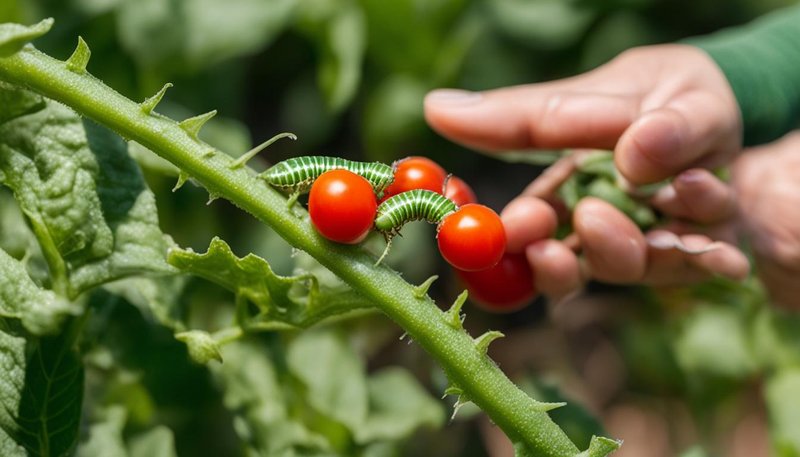
Now, you might be wondering how to tackle these sneaky pests without causing any damage to your plants. Picture this: you’re navigating a delicate dance, trying to spot these green devils while keeping your foliage intact. In this guide, I’ll walk you through the ins and outs of handpicking hornworms, including the best strategies and some handy tips to ensure your plants stay healthy.
Understanding Hornworms: The Basics
Hornworms, primarily the larvae of the tobacco hornworm and the tomato hornworm, are notorious for their voracious appetite. They’re typically green with a distinctive horn-like protrusion on their rear, which makes them easy to spot if you know what to look for. These critters can grow up to four inches long and can strip a plant bare in no time.
So, why should you care? Well, a single hornworm can devour the foliage of a tomato or pepper plant within days. If you’re growing a garden for fresh vegetables, these pests can be a real threat. The good news is that handpicking hornworms is an effective solution because it allows you to control the population while avoiding toxic pesticides, which can harm beneficial insects and the environment.
The best time to look for these little munchers is early in the morning or late in the day. They tend to be more active when it’s cooler, which makes them easier to spot. Moreover, their green color blends well with leaves, so patience is key!
How to Spot Hornworms on Your Plants
Finding hornworms might feel like searching for a needle in a haystack, but it’s not as difficult as it seems. Start by inspecting the plants closely. Hornworms usually like to hide on the undersides of leaves or deep within the foliage.
Here’s how to make it easier:
- Look for damage: Check for any missing leaves or chewed-up foliage. If you see this, it’s a good sign there might be a hornworm nearby.
- Search during peak hours: Early morning or late afternoon are prime times to find them because they’re more active.
- Use your senses: If you hear a crunching sound, you might be near a hornworm. They tend to chomp loudly when munching on leaves.
By knowing where to look and when, you’ll have a better chance of spotting these garden villains before they do too much damage.
Gathering Your Supplies
Before you set out on your hornworm-hunting mission, it’s crucial to have the right supplies on hand. You don’t need fancy tools, just a few basics will do. Here’s what I recommend:
- Gloves: While it’s not necessary, gloves can protect your hands and make you feel a bit more invincible.
- Container: A small bucket or container is useful for collecting the hornworms as you find them. You can even repurpose an old jar or plastic container!
- Garden scissors: These can help in case you need to cut a branch or leaf to retrieve a particularly well-hidden hornworm.
Having these items ready will make your task more efficient and enjoyable, letting you focus on the hunt rather than scrambling for supplies.
Handpicking Hornworms: The Process
Now that you’re equipped and ready, let’s dive into the actual process of handpicking hornworms. It’s simpler than you might think, but it does require a bit of finesse to avoid damaging your plants.
1. **Identify the Plant:** Start with the most affected plants, usually those with visible damage.
2. **Gently Move Leaves:** Carefully hold back leaves to expose the hidden areas where hornworms like to hang out.
3. **Look for the Hornworm:** Scan for that distinctive green color and the horn on their back. If you spot one, approach slowly.
4. **Use Your Fingers or Scissors:** If it’s reachable, gently grab the hornworm with your fingers. If it’s deep within the foliage, use your scissors to cut the branch carefully, bringing it closer to you.
5. **Place it in Your Container:** Drop the hornworm into your container. Feel free to admire your catch!
Where to Take the Hornworms
Once you’ve gathered your hornworms, you might wonder what to do with them. Simply tossing them onto the ground isn’t the best option since they could find their way back to your plants. Here are a couple of ideas:
- Relocate: Consider relocating them to another area of your garden far from your main plants.
- Feed Them to Chickens or Fish: If you have chickens or a fish tank, both love a good hornworm snack! It’s a win-win situation.
Just make sure the new location is suitable for them if you choose to release them back into nature.
Preventing Future Infestations
After handpicking, you may want to consider how to keep these hornworms from returning. A proactive approach can go a long way. Here are some tips:
- Regular Inspections: Make it a habit to check your plants regularly. Early detection can save your garden.
- Encourage Beneficial Insects: Ladybugs, lacewings, and parasitic wasps help control hornworm populations naturally.
- Crop Rotation: Change up your planting layout each year to confuse pests.
By integrating some preventive measures, you can enjoy a thriving garden without the distress of hornworms.
When to Seek Help
Sometimes, despite best efforts, hornworms might still become a problem. If you find that handpicking alone isn’t enough to keep your plants healthy, it might be time to consider other control methods. Don’t hesitate to reach out to local agricultural extensions or gardening clubs for advice.
You might be wondering whether organic pesticides are an option. While it can feel like a last resort, products containing *Bacillus thuringiensis* (Bt) are a natural solution that targets hornworms specifically.
Remember, it’s essential to act quickly before a small problem turns into a huge one. Keep an eye on your plants and don’t hesitate to enlist help if you need it.
Wrapping It Up
Handpicking hornworms is an effective, environmentally-friendly way to protect your plants without resorting to harsh chemicals. With a little patience and persistence, you can keep your garden healthy and flourishing. Just remember to check regularly, gather your supplies, and enjoy the simple act of caring for your plants.
Ultimately, gardening is all about balance, and while those hornworms can be pesky, they’re just part of the ecosystem. With this guide, you’re ready to tackle them head-on and save your beloved plants from becoming their next meal. Happy gardening!

